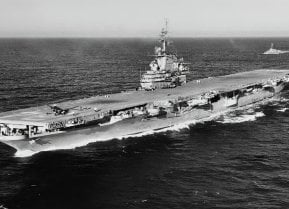USS Oriskany: Why the U.S. Navy Sunk Its Own Aircraft Carrier
The USS Oriskany was the first former warship and largest to be intentionally sunk in U.S. coastal waters – 22 miles south of Pensacola.
The final Essex-class aircraft carrier constructed, the USS Oriskany (CV/CVA-34), arrived too late to see service during the Second World War. However, after a successful career with the United States Navy – during which she was awarded the Navy Unit Commendation on three occasions, the Meritorious Unit Commendation three times; while she earned the Korean Service Medal and two Battle Stars, and the Vietnam Service Medal and 10 Battle Stars – the vessel has served a notable post-career role as an artificial reef.
USS Oriskany was decommissioned in 1976, and she was sent to the reserve fleet.
It was determined in the 1980s that it would be too expensive to modernize the vessel, and at the end of the Cold War, her hull was stripped of all equipment that could be reused or recycled.
However, the U.S. Navy retook possession of the warship in 2004, and she was transferred to the State of Florida for use as an artificial reef. The Navy had awarded a contract to Resolve Marine Group/ESCO Marine Joint Venture a year earlier for the environmental remediation work necessary for sinking the ship as an artificial reef.
The contractor towed the ship to Corpus Christi, Texas, in January 2004 and completed the environmental preparation work in December 2004. The extensive preparations for sinking the ship included the removal of any materials that might be toxic to the underwater environment, as well as stripping off insulation and wiring, which could pose entrapment threats to rovers and divers.
It took three years and roughly $20 million to prepare the warship for sinking, yet it took just 36 minutes for the retired carrier to sink to her current resting depth of 212 feet.
The Final Resting Place for the Carrier
A team of U.S. Navy personnel accomplished the sinking of the ship on May 17, 2006, and they were supported by the Florida Fish and Wildlife Conservation Commission, Escambia County Department of Natural Resources, the U.S. Coast Guard, the Pensacola Police Department, and several sheriff departments of Escambia County and surrounding counties.
A Navy Explosive Ordnance Disposal team from Panama City, Florida, detonated C-4 explosive charges of approximately 500 lb (230 kg), strategically placed on 22 sea connection pipes in various machinery spaces.
As was intended, the Essex-class carrier came to rest lying upright. With the help of a nice Gulf current, she is still flying her American Flag!
The USS Oriskany was the first former warship and largest to be intentionally sunk in U.S. coastal waters – 22 miles south of Pensacola. The water depth to the top of the ship is 80 feet, and the flight deck is 145 feet, making the former carrier a popular dive location. However, it is recommended that special equipment be employed and that divers receive additional training before venturing to the warship.
Divers are also reminded that steel artificial reef materials, including that of the sunken warship, will gradually experience structural changes as metal components naturally corrode in the marine environment.
USS Oriskany: The Great Aircraft Carrier Reef
Within just months, plants and shellfish had begun to attach themselves to the hulking vessel. Today, she is known among the diving community as "The Great Carrier Reef," and is also considered the "Everest" of shipwreck dives.
The Times of London named the USS Oriskany wreck as one of the top ten wreck diving sites in the world.
Experienced divers can work their way through doors and down stairwells, and even swim deep into the hangar bays and the flag bridge. Visitors to the ship are of course reminded to take only pictures and leave only bubbles.
In addition to divers, the rusting behemoth is frequented by whale sharks, tiger sharks, and hammerheads, while manta rays, octopuses, and other undersea creatures now call the Oriskany Reef home.
Author Experience and Expertise
Peter Suciu is a Michigan-based writer. He has contributed to more than four dozen magazines, newspapers, and websites with over 3,200 published pieces over a twenty-year career in journalism. He regularly writes about military hardware, firearms history, cybersecurity, politics, and international affairs. Peter is also a Contributing Writer for Forbes and Clearance Jobs. You can follow him on Twitter: @PeterSuciu.


